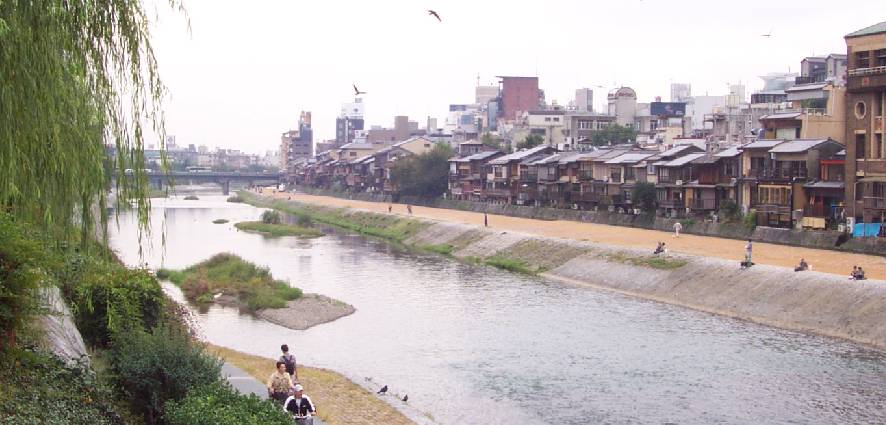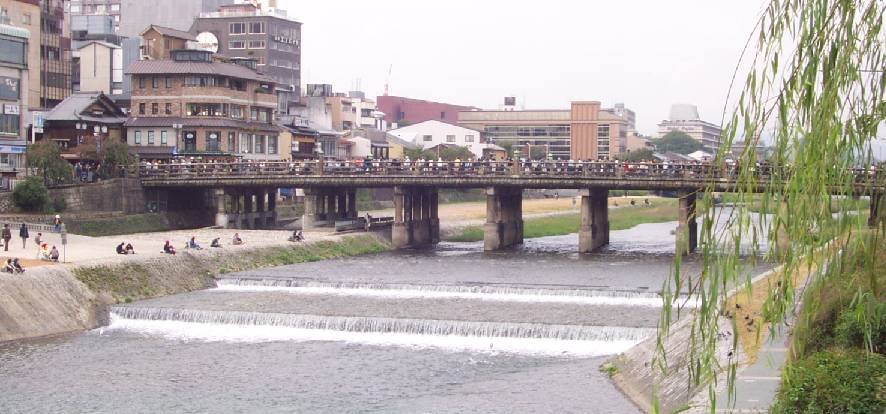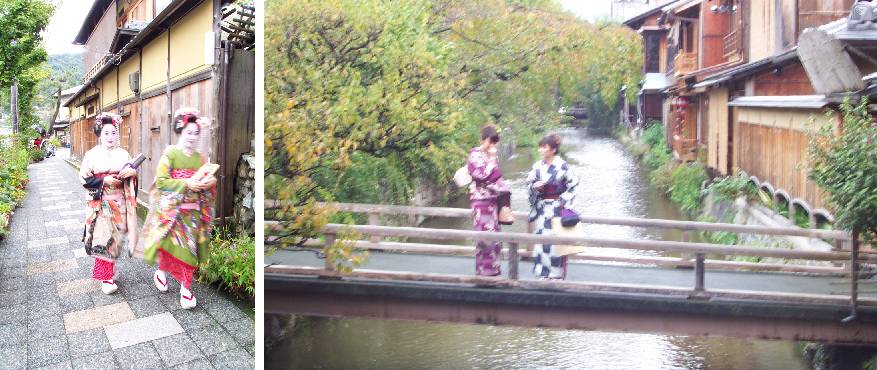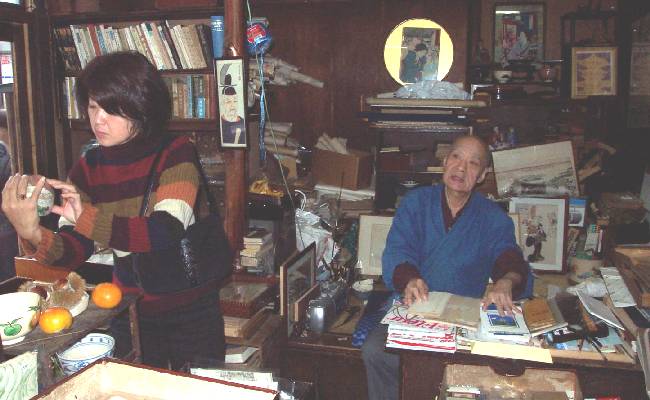Sightseeing and Antique Shopping in "Old Kyoto"
During a recent combo "family vacation/business trip" to Japan this just-past September, several enjoyable days were spent
"kicking about" my favorite Japanese town, Japan's ancient capitol Kyoto. Untouched by the ravages of wartime, Kyoto remains
today in many little ways much as it did during the 1800's. Old buildings, temples, and shrines still exist--some indeed untouched
for centuries.
Whatever the reason, whatever its charm, Kyoto beckons to me each and every time I'm fortunate enough to visit my wife Hisako's
nativeland of Japan. And so, a full two of our six "on-the-ground" days were spent there.

Looking north from Kyoto's "Great Sanjo Bridge," Tea Houses along the banks of the Kamogawa River

A close-up view of Kyoto's "Great Sanjo Bridge" -- Endpoint (and Station #55) of the "Tokaido Highway"
In addition to the usual, seemingly "obligatory visit" that I must always pay to Kyoto's revered Kiyomizu Temple, much of the
remainder of two full days was simply spent exploring the alleyways and shopping about in western Kyoto along the Kamogawa River.
It was here that Kyoto-ites over the ages have gathered "to cool themselves" along the shores of this ancient waterway and to enjoy
seasonal fireworks and other delights. Today, tourists find it to be a delightful area as well. Always enjoyable, with always a
seemingly unexpected surprise around every corner, Kyoto seems to never disappoint.

Vacationing and "shopping about" in Kyoto is always a delightful adventure....
Shopping for Antiques along the Kamogawa River
Unable to read a single word of Japanese, all storefront's "signs" are equally confusing and therefore, frankly meaningless. For this reason,
and to most visitors, shopping anywhere in Japan always seems to be at the same time both a challenge and an adventure. Patience and
persistence are the attributes needed. And, a very few simple words can be greatly helpful: "Koto-hin-ya arimas-ka??"
(simply, "Does an antique store exist??"). Seldom is the reply fully understood, but with "gestures" (as to direction) and by
repeated inquiry along the way, occasionally an antique store can be found. (As the saying goes.... "even the blind dog
occasionally finds a bone.")
In this manner--and with a "little luck" thrown in--even the unfamiliar and unknowing foreigner CAN eventually find an occasional
few antique (or "junk") shops which may prove to be of interest. With patience, occasional "gems" can be found.

Inside one of Kyoto's many hidden Antique and Junk shops
Old Hand-Carved Cherrywood Blocks Discovered
To our utter delight, in one such little cluttered shop we surprisingly spotted what appeared to be several old cherrywood blocks stacked up in
the shop's back corner (shown immediately below). They were old, they were quite dusty and dirty--but they were a delightful
find. Soon about a dozen hand-carved cherrywood woodblocks were spread out before us across the little shop's old wooden floor.
Exhausting all "in-hand" cash, most were purchased on the spot.
A quick questioning of the shop's owner revealed little further, other than that
they were spoken to be of the "Taisho" or "Showa" era (1912-26 and 1926-89 respectively) and were clearly all recognizable as being
of various "Kyoto locations."

Hand-Carved Cherrywood Woodblocks -- Various "Scenes of Kyoto"
A further closer examination made it clear that these cherrywood blocks were certainly "not new"--they showed signs of deep and
repeated applications of ink, and other wear. Nearly all were carved on BOTH sides; the fronts being the intricately carved
"key-block" face, and the backs having been carved as one of the additional "colored" blocks needed. Nevertheless, they were
remarkably heavy for their sizes and their cherrywood faces
were indeed strong, with most of their thin "key-lines" still nicely intact. Best guess, these were likely of late-1910's to 1930's vintage.
Clearly all appeared to have been likely intended as "tourist prints."
Days Later.... Back Home--OK, Let's "Try Printing" Them
To give collectors a better idea of the care and detail which went into the design and carving of these various cherrywood blocks,
we decided upon our return to stateside USA to "give them a try" with some black ink. Some old containers of ink were located along
with some sheets of Japanese paper, and
a toothbrush (of all things!) was chosen when the usual brush was not readily found. Despite this author's very limited actual
"hands-on" experience at printing (having self-carved and self-printed only two small prints in the late 1990's), some success was
achieved after some effort and experimentation.
Set Up for Printing
Although the very first efforts with each "block" were somewhat disappointing, after some repeated "inkings" which appeared to
"moisten and freshen" the block's faces, satisfactory (albeit not perfect) results were obtained. The actual printing from
these little blocks is shown below.

"Inking" the Block (left) and Rubbing with "Baren" (right)

"Rolling Back" the Paper (left) and the "Finished" ("key-block") Print (right)
In turn then, each of these various Kyoto cherrywood blocks were one by one brought back to life, with delightful printings "pulled"
from each block. A couple further results are of the printings from these little blocks is shown just below.

A Couple More Examples: Small Print Enlarged (left) and Larger Block with Printing (right)
An Afterthought
Although perhaps not of great interest to all of our readers, hopefully this short article will give collectors some small
degree of greater appreciation toward their own woodblock prints. It is instructive to always remember that these "simple little
printed sheets" of paper that we call "woodblocks" exist today for our enjoyment and study thanks to countless hours of tedious
"hands-on" effort of the various Japanese artisans who skillfully produced them.
Clearly, as collectors, we owe these artisans a very large collective debt of appreciation.
Literature (and print) sources used in preparation of this and other articles include:
Above documented Various "Scenes of Kyoto" Cherrywood Blocks
"Guide to Modern Japanese Woodblock Prints: 1900-1975", by Helen Merritt and Nanako Yamada, University of Hawaii Press, Honolulu, ISBN 0-8248-1732-X
"Kawase Hasui -- The Complete Woodblock Prints", by Kendall H. Brown & Shoichiro Watanabe, Hotei (KIT) Publishing, Netherlands, ISBN 90-74822-46-0
(c) Thomas Crossland and Dr. Andreas Grund, December 2003
Gallery
Terms
Ordering
About Us
We Buy Prints
Library

